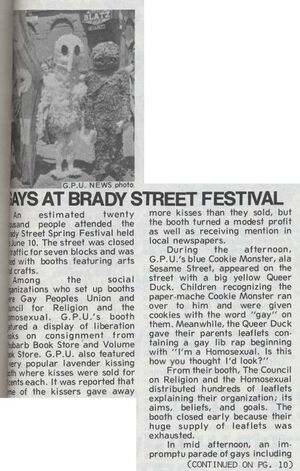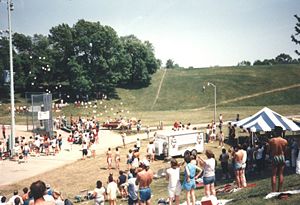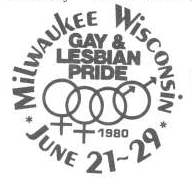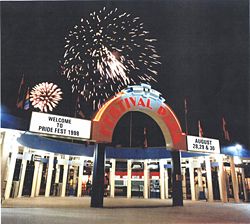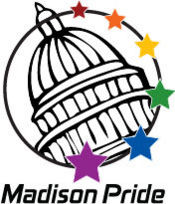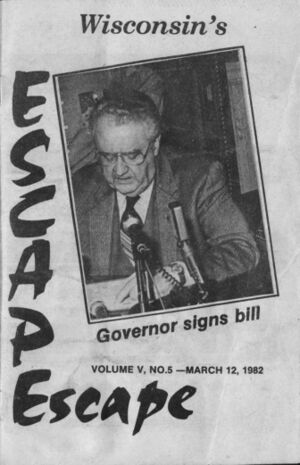Difference between revisions of "Wis. LGBT History-- Events"
| Line 40: | Line 40: | ||
A sampling of the Events listed on the web site follows: | A sampling of the Events listed on the web site follows: | ||
| + | [[Image:gpunews-7307-p01-brady-st-festival.jpg|thumb|right|July 1973 article, GPU at Brady Street Festival]] | ||
===Brady Street Festival=== | ===Brady Street Festival=== | ||
'''Milwaukee (1970's-1980's)''' | '''Milwaukee (1970's-1980's)''' | ||
| − | |||
According to Milwaukee's Shepherd Express, "Any Milwaukee native old enough to remember the 1960s will remember the Brady Street Festival. At the time, the street itself was in transition from old-time Italian neighborhood to Milwaukee's hippie mecca, the local answer to Haight-Ashbury. Echoing that tie-dyed spirit, neighborhood merchants and activists organized a festival featuring local bands and vendors. It was a mainstay of summer entertainment in Milwaukee..." | According to Milwaukee's Shepherd Express, "Any Milwaukee native old enough to remember the 1960s will remember the Brady Street Festival. At the time, the street itself was in transition from old-time Italian neighborhood to Milwaukee's hippie mecca, the local answer to Haight-Ashbury. Echoing that tie-dyed spirit, neighborhood merchants and activists organized a festival featuring local bands and vendors. It was a mainstay of summer entertainment in Milwaukee..." | ||
| Line 56: | Line 56: | ||
The 2007 Festival did feature a 45 minute drag show, promoted as "a Fashion Drag Show". Scheduled to start at 7:15pm, it didn't kick off until close to 7:45pm (typical queens, fashionably late), but it was a great show. It was obvious that many of the spectators had never seen a drag show before. This observer enjoyed watching the crowd (a lot of eye candy), but most fun was watching numerous "straight" couples: invariably the young woman was entranced, and excited- cheering, clapping, etc.. Meanwhile, the young male partner was in shock- uncertain how to handle the situation, anxious to get away but also somewhat curious, and especially startled by his female partner's reaction to the show. (I overheard more than one young man say to his date "no way that's a man".) It was a great way to bring "gay" back to the Brady Street Festival! | The 2007 Festival did feature a 45 minute drag show, promoted as "a Fashion Drag Show". Scheduled to start at 7:15pm, it didn't kick off until close to 7:45pm (typical queens, fashionably late), but it was a great show. It was obvious that many of the spectators had never seen a drag show before. This observer enjoyed watching the crowd (a lot of eye candy), but most fun was watching numerous "straight" couples: invariably the young woman was entranced, and excited- cheering, clapping, etc.. Meanwhile, the young male partner was in shock- uncertain how to handle the situation, anxious to get away but also somewhat curious, and especially startled by his female partner's reaction to the show. (I overheard more than one young man say to his date "no way that's a man".) It was a great way to bring "gay" back to the Brady Street Festival! | ||
| + | [[Image:milwclassic-memday88d.jpg|300px|right|Photo of Milw. Classic softball games, summer 1988]] | ||
===Wreck Room Classic=== | ===Wreck Room Classic=== | ||
'''Milwaukee (1977-present)''' | '''Milwaukee (1977-present)''' | ||
| − | |||
The Wreck Room Classic was a softball invitational tournament held every Memorial Day weekend and hosting teams from virtually every major city in the country during its heyday. The tournament went into decline when other cities also got into the tournament game; the draw of attending a Memorial Day tournament in Atlanta or New York was too much for Milwaukee to compete with. The tournament continues in reduced form, known as The Milwaukee Classic (sponsored by the SSBL). | The Wreck Room Classic was a softball invitational tournament held every Memorial Day weekend and hosting teams from virtually every major city in the country during its heyday. The tournament went into decline when other cities also got into the tournament game; the draw of attending a Memorial Day tournament in Atlanta or New York was too much for Milwaukee to compete with. The tournament continues in reduced form, known as The Milwaukee Classic (sponsored by the SSBL). | ||
| + | [[Image:80prd_logo.jpg|thumb|right|Milwaukee 1980 Pride logo]] | ||
===Pride Celebrations and PrideFest=== | ===Pride Celebrations and PrideFest=== | ||
'''Statewide (1970s-present)''' | '''Statewide (1970s-present)''' | ||
| − | |||
The GPU was the first organization in Milwaukee to host an event that had “Pride” appeal, with over 350 people attending the GPU Ball in 1974. Other dances and parties were hosted in the years that followed, and by 1981, a subgroup of the GPU, the Milwaukee Pride Week Committee, was coordinating activities of various organizations and also organized marches/ parades, rallies, and street festivals. | The GPU was the first organization in Milwaukee to host an event that had “Pride” appeal, with over 350 people attending the GPU Ball in 1974. Other dances and parties were hosted in the years that followed, and by 1981, a subgroup of the GPU, the Milwaukee Pride Week Committee, was coordinating activities of various organizations and also organized marches/ parades, rallies, and street festivals. | ||
| Line 72: | Line 72: | ||
The march and rally were held at Cathedral Square again in 1990. In 1991, 1992 and 1993 the rally was moved to Juneau Park along the lake front, an area that could accommodate the growing crowds. Entertainment and food were added, creating a festival atmosphere. | The march and rally were held at Cathedral Square again in 1990. In 1991, 1992 and 1993 the rally was moved to Juneau Park along the lake front, an area that could accommodate the growing crowds. Entertainment and food were added, creating a festival atmosphere. | ||
| − | [[Image:pride98.jpg| | + | [[Image:pride98.jpg|250px|left|PrideFest at Milwaukee's lakefront festival park, 1998]] |
In 1994, having outgrown the Juneau Park area, the new PrideFest event was moved to Veterans Park, featuring exhibits, several stages for entertainment, craftspeople and vendors, multiple food outlets and a full two days of activity. This was repeated for PrideFest ‘95 with the addition of the “Light Up the Sky with Pride” fireworks and laser light show. By this time, approximately 10,000 people were attending. | In 1994, having outgrown the Juneau Park area, the new PrideFest event was moved to Veterans Park, featuring exhibits, several stages for entertainment, craftspeople and vendors, multiple food outlets and a full two days of activity. This was repeated for PrideFest ‘95 with the addition of the “Light Up the Sky with Pride” fireworks and laser light show. By this time, approximately 10,000 people were attending. | ||
| Line 79: | Line 79: | ||
The story of Milwaukee's celebration of Pride has not been one of all successes however. After Pridefest 2003, the PrideFest organization nearly went bankrupt. Pridefest 2004 was cut back to 2 days and eliminated the parade and other components, all in efforts to save money for the struggling organization. The Parade returned in 2005 (organized separately by OutBound Magazine and the Milwaukee bars), and in 2006 PrideFest returned to 3 days and the Parade route was decorated with Pride banners for the month prior to the event. By 2008, PrideFest was back on solid financial footing: despite record downpours of rain all 3 days, the 2008 fetival still came out ahead financially (largely because of headliner acts drawing people); and the 2009 festival, with great weather all 3 days, was another solid event- and continues to be one of the largest and best organized Pride events in the country. | The story of Milwaukee's celebration of Pride has not been one of all successes however. After Pridefest 2003, the PrideFest organization nearly went bankrupt. Pridefest 2004 was cut back to 2 days and eliminated the parade and other components, all in efforts to save money for the struggling organization. The Parade returned in 2005 (organized separately by OutBound Magazine and the Milwaukee bars), and in 2006 PrideFest returned to 3 days and the Parade route was decorated with Pride banners for the month prior to the event. By 2008, PrideFest was back on solid financial footing: despite record downpours of rain all 3 days, the 2008 fetival still came out ahead financially (largely because of headliner acts drawing people); and the 2009 festival, with great weather all 3 days, was another solid event- and continues to be one of the largest and best organized Pride events in the country. | ||
| − | [[Image:madison-pridelogo2.jpg| | + | [[Image:madison-pridelogo2.jpg|175px|right|]] |
Pride celebrations are not restricted to Milwaukee. Since the mid-1970s, Madison has hosted an annual Pride celebration around the 3rd weekend in July, usually comprised of the MAGIC Picnic on Saturday afternoon, and a parade from the State Capitol and up State Street on Sunday. Since the early 1980's, Madison's MAGIC picnic has been one of the state's leading summer events for gays and lesbians, usually sited in Brittingham Park. And farther north, since their beginnings in the late 1970’s as an “appreciation beer bust” for local gay bar patrons at a rural county park, pride events in northeast Wisconsin - an area loosely defined by Green Bay, the Fox Cities and Sheboygan- have also been a tradition. | Pride celebrations are not restricted to Milwaukee. Since the mid-1970s, Madison has hosted an annual Pride celebration around the 3rd weekend in July, usually comprised of the MAGIC Picnic on Saturday afternoon, and a parade from the State Capitol and up State Street on Sunday. Since the early 1980's, Madison's MAGIC picnic has been one of the state's leading summer events for gays and lesbians, usually sited in Brittingham Park. And farther north, since their beginnings in the late 1970’s as an “appreciation beer bust” for local gay bar patrons at a rural county park, pride events in northeast Wisconsin - an area loosely defined by Green Bay, the Fox Cities and Sheboygan- have also been a tradition. | ||
Revision as of 23:37, 2 March 2010
EVENTS in Wisconsin's LGBT History
The Events section of the web site is intended to include Regular as well as Special events. Regular events are annual and other scheduled occurences such as leather titles, pageants, pride celebrations, sporting events, etc. Special, Historic and Landmark events will largely be major news stories, everything from the good (such as rallies, laws and ordinances, etc.), to the bad (such as police harassment, murders etc.)
Events connected to particular persons, organizations, businesses, etc. may be included both here and cross-referenced to mentions in those related sections.
General Events:
Health
- 1993 Cryptosporidium outbreak
- Flu Vaccinations
- Lavender Hill Parties
Drag shows, Pageants, Titles
- Drag Titles and Performers
- Leather Titles
- Miss and Mr. Gay titles and shows (non-drag)
Pride events
- MAPFest
- Pride Celebrations
- PrideFest
Community and Social events (Dances, fundraisers, etc.)
- Brady Street Festival
Sporting events
- Holiday Invitational Tournament (HIT) (1979-date)
- Milwaukee Classic Softball Tournament
- Wreck Room Classic Softball Tournament
Special, Historic, and Landmark Events
- Bar raids
- Government relations
- Laws and Ordinances
- Plays and performing arts
- Police harassment and relations
- Tragedies
A sampling of the Events listed on the web site follows:
Brady Street Festival
Milwaukee (1970's-1980's)
According to Milwaukee's Shepherd Express, "Any Milwaukee native old enough to remember the 1960s will remember the Brady Street Festival. At the time, the street itself was in transition from old-time Italian neighborhood to Milwaukee's hippie mecca, the local answer to Haight-Ashbury. Echoing that tie-dyed spirit, neighborhood merchants and activists organized a festival featuring local bands and vendors. It was a mainstay of summer entertainment in Milwaukee..."
During its heyday, the Brady Street Festival was one of the fledgling gay community's best means of communicating with the general public and locating other gay people. The Gay Peoples Union (GPU) had information booths at the Festival for quite a few years in the 1970s. July 1973's GPU News reported: "Among the social organizations who set up booths are Gay Peoples Union and Council for Religion and the Homosexual. GPU's booth featured a display of liberation books on consignmnent from Rhubarb Book Store. GPU also featured the very popular lavender kissing booth where kisses were sold for 50 cents each. It was reported that some of the kissers gave away more kisses than they sold, but the booth turned a modest profit as well as receiving mention in local newspapers. During the afternoon, GPU's blue Cookie Monster, ala Sesame Street, appeared on the street with a big yellow Queer Duck. Children recognizing the paper-mache Cookie Monster ran over to him and were given cookies with the word "gay" on them. Meanwhile, the Queer Duck gave their parents leaflets containing the gay lib rap beginning with "I'm a homosexual. Is this how you thought I'd look?'"
A year later, September 1974's GPU News reported: "(GPU) had its booth in its regular location at Astor Stret. The gay kissing booth, which had created such a stir at past festivals, was not done this year. However, about a dozen GPU members sold T-shirts with the GPU trademark, handed out GPU NEws, and passed out between 700 and 800 helium-filled baloons with the word GAY printed. As usual, a group of neighborghood gays sponsored a 'Queen of Brady Street Contest'. Looking to 1984, all entries were appropriately decorated with electric applicances, including electric fan with curls and ribbons, a hair drier replete with wig. The winner was an old-fashioned Speed Queen washer with a large -- around the wringer."
But, according to the Shepherd Express, "The Brady Street Festival was a mainstay of summer entertainment in Milwaukee until Brady Street fell on hard times and crime in the '80s. The event disappeared for many years."
The Brady Street Festival first year of a real comeback was on Saturday, July 28, 2007, when it was promoted as follows: "This year the festival is returning to its former rainbow splendor." And "rainbow splendor" it was! The main Festival was still not quite up to its glory days of the 1970s, and there were no booths or displays for any LGBT organizations.
The 2007 Festival did feature a 45 minute drag show, promoted as "a Fashion Drag Show". Scheduled to start at 7:15pm, it didn't kick off until close to 7:45pm (typical queens, fashionably late), but it was a great show. It was obvious that many of the spectators had never seen a drag show before. This observer enjoyed watching the crowd (a lot of eye candy), but most fun was watching numerous "straight" couples: invariably the young woman was entranced, and excited- cheering, clapping, etc.. Meanwhile, the young male partner was in shock- uncertain how to handle the situation, anxious to get away but also somewhat curious, and especially startled by his female partner's reaction to the show. (I overheard more than one young man say to his date "no way that's a man".) It was a great way to bring "gay" back to the Brady Street Festival!
Wreck Room Classic
Milwaukee (1977-present)
The Wreck Room Classic was a softball invitational tournament held every Memorial Day weekend and hosting teams from virtually every major city in the country during its heyday. The tournament went into decline when other cities also got into the tournament game; the draw of attending a Memorial Day tournament in Atlanta or New York was too much for Milwaukee to compete with. The tournament continues in reduced form, known as The Milwaukee Classic (sponsored by the SSBL).
Pride Celebrations and PrideFest
Statewide (1970s-present)
The GPU was the first organization in Milwaukee to host an event that had “Pride” appeal, with over 350 people attending the GPU Ball in 1974. Other dances and parties were hosted in the years that followed, and by 1981, a subgroup of the GPU, the Milwaukee Pride Week Committee, was coordinating activities of various organizations and also organized marches/ parades, rallies, and street festivals.
The first official Pride event, hosted by the new Milwaukee Lesbian/Gay Pride Committee (MLGPC), was held in 1988, complete with a softball tournament, ball, town hall meeting with elected officials and film festival. Several hundred people participated in the various events. In 1989, a march was organized in June. Approximately 500 people marched the two miles from the bar district, around City Hall and to Cathedral Square for a rally where another 500 people had gathered. This particular event generated a great deal of controversy in the City of Milwaukee, especially when the proclamation from Mayor John Norquist ended with the words, “We are proud of who you are.” Both the mayor and county executive were threatened with recall campaigns initiated by religious-based conservative groups. By the end of the day, the MLGPC march and rally was the opening story on all three major news telecasts and featured on the front page of the Sunday Milwaukee Journal. However, the experience did not deter planners for the following year. In fact, the experience turned out to be a rallying point for many people in the LGBT community, spurring more people to get involved with the community.
The march and rally were held at Cathedral Square again in 1990. In 1991, 1992 and 1993 the rally was moved to Juneau Park along the lake front, an area that could accommodate the growing crowds. Entertainment and food were added, creating a festival atmosphere.
In 1994, having outgrown the Juneau Park area, the new PrideFest event was moved to Veterans Park, featuring exhibits, several stages for entertainment, craftspeople and vendors, multiple food outlets and a full two days of activity. This was repeated for PrideFest ‘95 with the addition of the “Light Up the Sky with Pride” fireworks and laser light show. By this time, approximately 10,000 people were attending.
The biggest accomplishment made for Milwaukee's celebration of LGBT Pride was PrideFest's move to the Henry W. Maier Festival Park in 1996, the best festival facility in the U.S. With permanent stages complete with professional lighting, food buildings, vendor pavilion and support of the staff from Milwaukee World Festivals Inc, the managing body of the park, PrideFest joined 13 other festivals that used the park for their events. In fact, PrideFest has had the distinctive honor of kicking off the Festival season for Milwaukee almost every year since 1996, which has become known as the City of Festivals.
The story of Milwaukee's celebration of Pride has not been one of all successes however. After Pridefest 2003, the PrideFest organization nearly went bankrupt. Pridefest 2004 was cut back to 2 days and eliminated the parade and other components, all in efforts to save money for the struggling organization. The Parade returned in 2005 (organized separately by OutBound Magazine and the Milwaukee bars), and in 2006 PrideFest returned to 3 days and the Parade route was decorated with Pride banners for the month prior to the event. By 2008, PrideFest was back on solid financial footing: despite record downpours of rain all 3 days, the 2008 fetival still came out ahead financially (largely because of headliner acts drawing people); and the 2009 festival, with great weather all 3 days, was another solid event- and continues to be one of the largest and best organized Pride events in the country.
Pride celebrations are not restricted to Milwaukee. Since the mid-1970s, Madison has hosted an annual Pride celebration around the 3rd weekend in July, usually comprised of the MAGIC Picnic on Saturday afternoon, and a parade from the State Capitol and up State Street on Sunday. Since the early 1980's, Madison's MAGIC picnic has been one of the state's leading summer events for gays and lesbians, usually sited in Brittingham Park. And farther north, since their beginnings in the late 1970’s as an “appreciation beer bust” for local gay bar patrons at a rural county park, pride events in northeast Wisconsin - an area loosely defined by Green Bay, the Fox Cities and Sheboygan- have also been a tradition.
Gay Rights Law passed
Statewide (1981/1982)
Wisconsin was the first state in the union to adopt a "Gay Rights Law". AB70, the nation’s first successfully enacted gay civil rights legislation, was introduced before the Wisconsin legislature in 1981, largely through the efforts primarily of Milwaukee gay activist Leon Rouse and Wisconsin State Representative David Clarenbach. The bill was signed into law in March, 1982 by the Governor Lee Sherman Dreyfus. The bill added sexual orientation to a list of characteristics - such as race, age, gender, and ethnicity - that may not be used to discriminate in employment, housing or other public accommodation. Thirteen other states have followed Wisconsin’s lead in the last quarter century.
- Return to INTRO page: Wisconsin LGBT History Project- Intro
Explore the full web site documenting GLBT life in Milwaukee, Madison, Green Bay, and all of Wisconsin at: http://www.WisconsinGayHistory.org
Source: All contents of this page copyrighted by Don Schwamb of the Wisconsin LGBT History Project.
